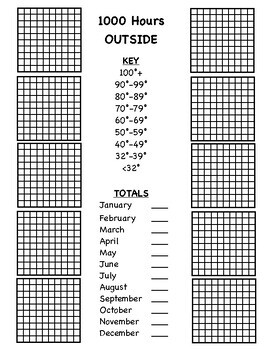1000 Hours Outside Tracker
- PDF
Description
This is a visual tracker to log your 1000 hours outside! Follow the movement started by influencer and podcaster Ginny Yurich.
First, determine what colors to represent each degree span.
Go outside and begin accumulating hours (and memories)!
Fill in what the temperatures were for the hours spent outdoors, and at the end of the year, the chart will show how much time was spent outside in each temperature range!
This is a great way to visualize the "1000 Hours" goal AND work on:
-fractions
-percentages
-reading a clock
-reading a thermometer
-skip counting for reading analog clocks and thermometers
-elapsed time
-predictable weather for each season
-math sense and understanding base 10 counting
-averages
-rounding
Some types of questions to ask while filling in the chart:
To be "on track" at the end of March, how many hours should we have filled in?
How many hours on average should we get each day?
How many minutes are in 2.74 hours?
How much time has passed if we were outside from 4:07-7:01?
How many full hours does that round to?
How many hours do you estimate we will get in May?
How much time were we outside if we started at 3:57 and came in at 6:05?
How many hours does 2 hours and 8 minutes round to?



